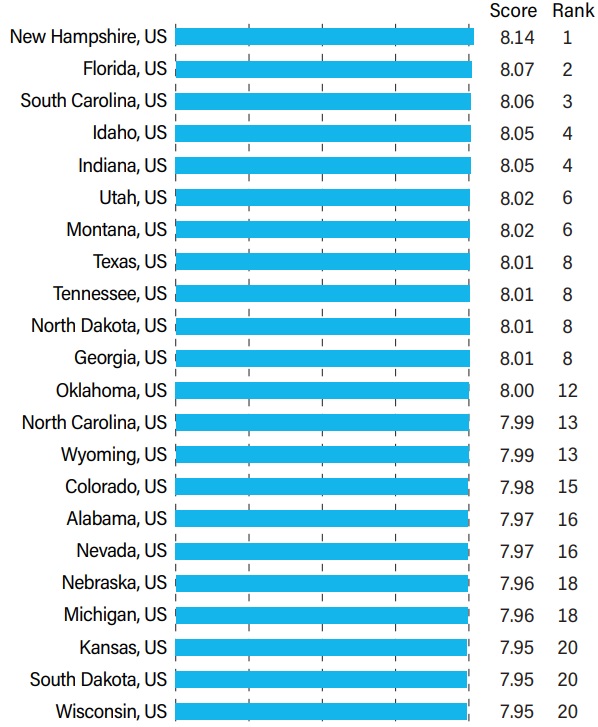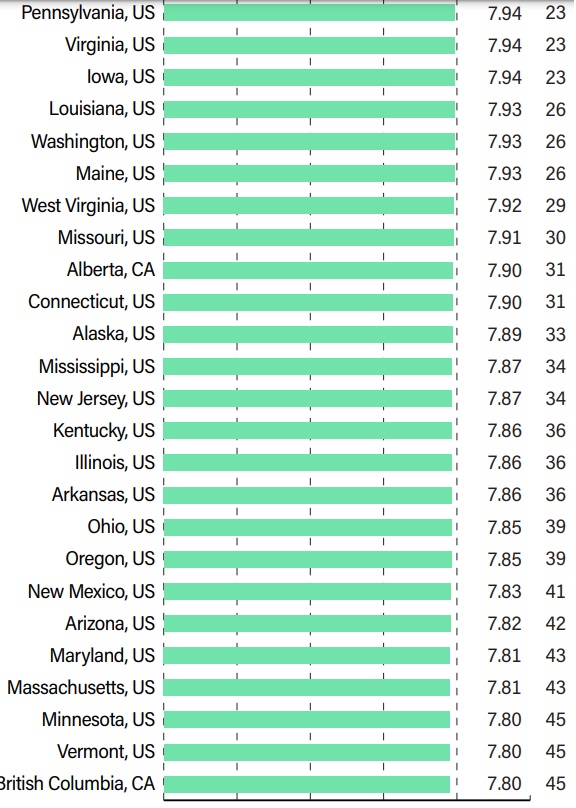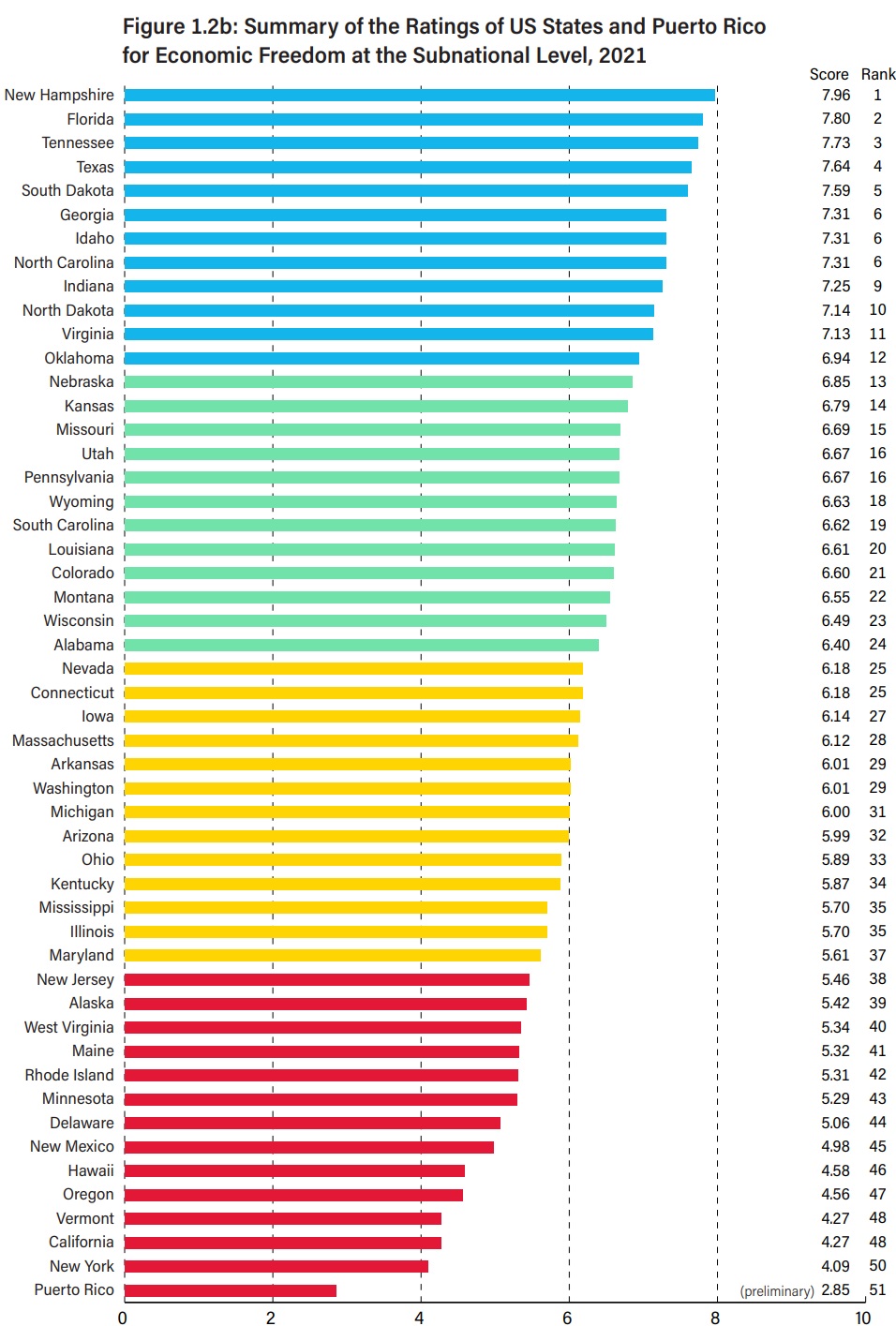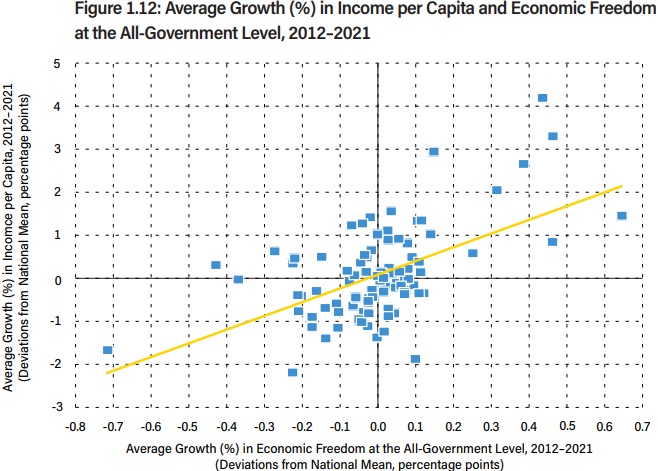Yesterday’s column, based on Freedom in the 50 States, applauded New Hampshire for being the most libertarian state and the most market-oriented state.
Today, let’s look at the Economic Freedom of North America, published by the Fraser Institute, which also measures and ranks economic freedom for Canadian provinces and Mexican states.
Lo and behold, the most laissez-faire jurisdiction in North America is still New Hampshire. Here are the jurisdictions (all from the USA) in the top quartile.

Here’s some analysis from the report.
The top jurisdiction in the all-government index of Economic Freedom of North America 2023 is New Hampshire at 8.14, followed by Florida (8.07), South Carolina (8.06), and then Idaho and Indiana, tied for fourth (8.05). Alberta is the highest-ranking Canadian province, tied for 31st place with a score of 7.90. The next highest Canadian province is British Columbia in 45th at 7.80. Alberta had spent seven years at the top of the index but fell out of the top spot in the 2018 report (reflecting 2016 data) and has fallen further to outside the top 20 since then. For the first time, we have made a preliminary attempt to include the US territory of Puerto Rico in the US all-government index. Puerto Rico ranks 61st at 6.65, 0.82 below the lowest-ranked Canadian province and only 0.08 above the highest-ranked Mexican state. The highest-ranked of the 32 Mexican states are Baja California and Chihuahua with 6.62, followed by Nayarit (6.57), Baja California (6.56), Yucatan (6.53), and Tlaxcala (6.52). They are nearly a full point behind those ranking lowest in Canada and the United States. The lowest-ranked Mexican state is Ciudad de México at 5.55, followed by Colima at 5.88, and Campeche at 6.02.
Here are the jurisdictions in the second quartile.
You’ll notice that Alberta is the highest-ranked Canadian province, ranking between Missouri and Connecticut.
British Columbia has squeaks into the second quartile.

Here’s some more analysis from the report.
Seven of the Canadian provinces are ranked behind all 50 US states. Newfoundland & Labrador is 60th with a score of 7.47, just behind Prince Edward Island and New Brunswick (7.52), and Nova Scotia (7.54). The lowest ranked of the United States are Delaware (53rd, 7.69), New York (52nd, 7.71), and Hawaii (tied for 50th, 7.74). Historically, average economic freedom in all three countries peaked in 2004 at 7.75 then fell steadily to 7.27 in 2011. Canadian provinces saw the smallest decline, only 0.24, whereas the decline in the United States was 0.45 and, in Mexico, 0.59. Average economic freedom in North America had risen slowly to 7.46 by 2017 but still remained below that 2004 peak. (Canada was an outlier in that period, seeing a steady decline since 2014.) Since 2017, average economic freedom has fallen further to 7.32. The vast majority of that decline occurred in 2020, which reflects the government response to the COVID-19 pandemic.
Here’s the third quartile, showing the worst American states (sarcastic congratulations to Delaware, with New York, Hawaii, and California also receiving dismal scores).

I won’t bother sharing the last quartile since it is noting but Mexican states.
Economic policy in North America is determined by a combination of national policies and sub-national policies, so EFNA also crunches the numbers so you can see how sub-national governments perform on the policies they control.
For comparisons of jurisdictions within the same country, the subnational indices are most appropriate. Figures 1.2a, 12b, and 1.2c show the subnational indices for Canada, the United States, and Mexico. Because much of the new government spending in response to the COVID-19 pandemic was done at the federal level, we did not see a decline in the subnational averages for Canada and the United States… Figure 1.2b (p. 8) shows the subnational scores for the US states. New Hampshire (7.96) returned to the top spot. Florida fell to second with 7.80, followed by Tennessee (7.73), Texas (7.64), and South Dakota (7.59).2 The least-free state was again New York with 4.09, well behind California and Vermont (4.27), Oregon (4.56), Hawaii (4.58), and New Mexico (4.98).
Since nearly 80 percent of readers are American, I’ll share the data for the United States.
New Hampshire and Florida claim that top-two spots, but there are somewhat significant differences for other states (South Carolina, for instance, falls from #3 to #19).

Let’s close by looking at one final visual from the study.
All of the above images merely show rankings for economic liberty.
Our last image shows that economic liberty has very significant correlation with growth in per-capita income.

The moral of the story is that jurisdictions that want more prosperity should limit the size and scope of government.


